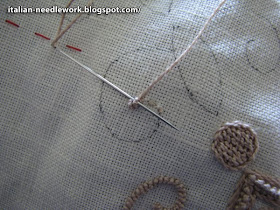We have talked about the different ways to use
Punto Avorio which appears in several Italian needlework techniques like
Puncetto needle lace.
It seems to be executed in many different ways in
Umbrian Embroidery. We saw it used as a filling – packed tightly together (inside the
circle motif) and used for a design line – widely spaced (for the
curlycue motif) and now as an edging which can then be used to join pieces of fabric together.
Here we use
Punto Avorio to secure the hem and to begin one of the motifs of
Umbrian Embroidery called "
Pignattina".
For those of you who are curious: the fabric I'm using is Ivory-coloured
Sotema 20L 38ct linen, a tapestry no. 26 needle and Ecrù-coloured (926)
Anchor Coton a Broder no. 25 thread.
While I was shooting the following photos this morning, the weather changed about 4 times, from dark, heavy clouds to pouring rain to sunshine to light clouds so I'm sorry if the lighting is so varied!
Here in photos 1 and 2, I did some
Punto Avorio stitches along the hem going from left to right and then to do the
Pignattina motif, I worked back toward the right slipping under only the threads in the spaces of the previous stitches. Click on the photos for a closer look.
Going back, I did 7
Punto Avorio stitches, then forward again 7, back 7 and so on until I had five rows of 7
Punto Avorio stitches sticking out over the hemline. They form a little rectangle. You can get a better idea of the height of my rectangle from photo 4.

At the end of my fifth row, I am on the left-hand side of my
Pignattina motif. At this point I go down to my hemline and do another
Punto Avorio stitch into the next open space to the left so that I get a little leg beside my motif (photo 3).
In photo 4 I go back up and do another
Punto Avorio stitch in between the first two stitches of my row so that now I have two legs.
Back down beside what I did in photo 3, I make another
Punto Avorio stitch to the left. Now I have three legs (photo 5).
I cover the three legs together with 8
Punto Avorio stitches, working my way back up to the top left-hand side of my rectangle (photo 6).

In photo 7 I start back across the top of my rectangle with another row of 7
Punto Avorio stitches.
When I reach the right-hand side, I go down to my hemline and do another
Punto Avorio to match the others along the hem. I now have a leg to the right of my
Pignattina motif (photo 8).
Back up to the top and another
Punto Avorio stitch, like we did on the left-hand side, to make a second leg (photo 9). I will not, however make a third leg as I need to keep moving along my hemline to the right. Now I will cover my two legs with 8
Punto Avorio stitches (photo 10).

When I reach the hem again, I continue on with my
Punto Avorio stitches along the hemline until I want to make another motif.
Note: I used a pin to tack the fabric down to my chair so I could take photos - it is not required for the stitching. 
In between
Pignattina motifs, you can do a number of other things like these needlewoven picots called
Pifferini.

My tension needs work but it gets easier as you go on down the hemline. I basted my hem down and then after I was finished all the
Punto Avorio stitches, I cut away my basting.
You can leave these like this, or use them to attach your piece of embroidery to another piece. The
Pignattine fill the channel between the two attached pieces. If I understand correctly, you attach the two pieces together while executing the
Pignattina motifs of the second piece.
I'm going to stitch up a second hemline and give this a try. I'll let you know how it goes.

 Sorry I was too awestruck to get any historical data on this handkerchief – just means I'll have to go back for another look!
Sorry I was too awestruck to get any historical data on this handkerchief – just means I'll have to go back for another look!
















































